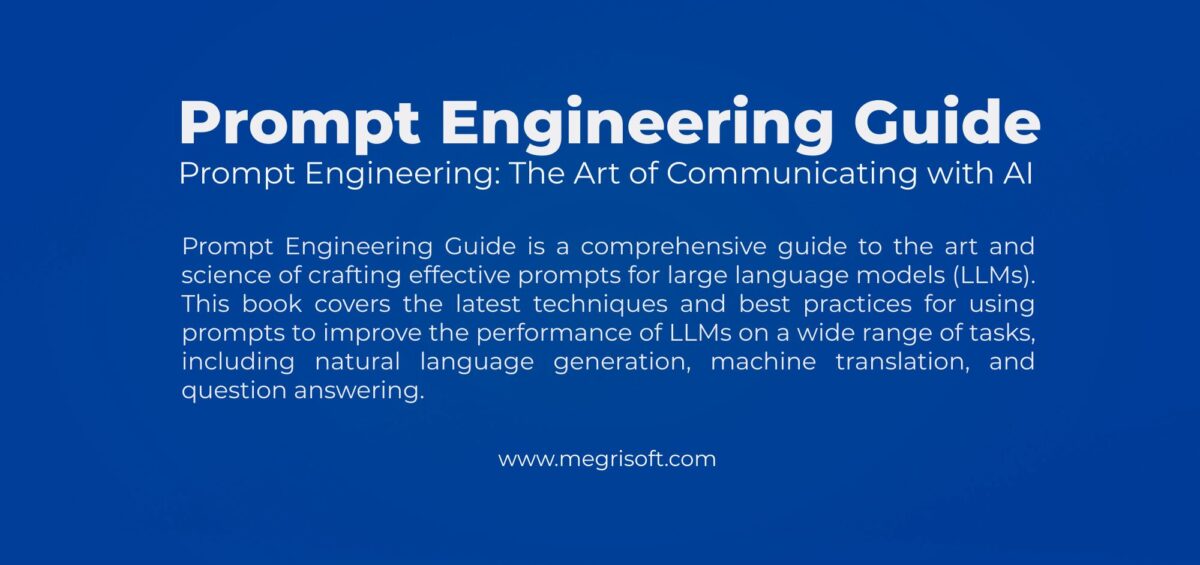Welcome to “Prompt Engineering: The Comprehensive Guide for Modern Developers and Researchers.” This guide will explore the art and science of crafting effective prompts for AI models. From understanding model behavior to optimizing outputs, join us on a journey to master the intricacies of prompt engineering in the ever-evolving world of artificial intelligence. Explore top best practices for crafting AI prompts, from ensuring clarity and context to avoiding biases. Enhance accuracy and relevance in AI responses.
Explore the intricate world of prompt engineering. In an era where AI responses need precision, learn how developers and researchers design prompts for optimal outcomes. This guide illuminates every corner of this evolving field, from foundational knowledge to advanced techniques.
- Introduction to Prompt Engineering
- What is Prompt Engineering? Prompt engineering refers to the thoughtful construction of input data for generative AI systems to generate optimal and desirable outputs. Prompt engineering is designing and crafting effective prompts for large language models (LLMs) and other AI models. Effective, prompt engineering involves the strategic organization of text to ensure it is comprehensible and meaningful for generative AI models. Prompt engineering is like building a strong connection between people and artificial intelligence. It’s a careful process of designing information we give AI systems so they can understand us better. It’s about asking questions and ensuring the AI understands the deeper meaning behind what we’re asking. As AI gets more advanced, prompt engineering becomes even more important. A well-designed prompt can give the AI thoughtful and detailed answers instead of generic ones. Prompt engineering is about having a clear and helpful conversation with AI by choosing the right words and ensuring we understand each other. As AI improves, learning how to do prompt engineering will become important for anyone who wants to get the most out of AI systems.
- Delve into the art and science of creating queries tailored to guide AI models toward desired responses. The art and science of creating tailored queries for AI models involves crafting carefully constructed inputs that steer the model toward producing desired and relevant responses. It requires a deep understanding of the model’s capabilities and limitations and a strategic approach to framing the queries for optimal outcomes.
- The Importance of Modern AI Development: Understand the pivotal role prompt engineering plays in achieving reliable and predictable AI interactions in today’s tech landscape. The Importance of Modern AI Development – Understand the pivotal role prompt engineering plays in achieving reliable and predictable AI interactions in today’s tech landscape. Prompt engineering is a rapidly growing discipline that is pivotal in modern AI development. The process of designing and crafting prompts guides AI models in generating desired outputs. Prompt engineering is essential for achieving reliable and predictable AI interactions, particularly in today’s increasingly complex and demanding tech landscape.
- What is Prompt Engineering? Prompt engineering refers to the thoughtful construction of input data for generative AI systems to generate optimal and desirable outputs. Prompt engineering is designing and crafting effective prompts for large language models (LLMs) and other AI models. Effective, prompt engineering involves the strategic organization of text to ensure it is comprehensible and meaningful for generative AI models. Prompt engineering is like building a strong connection between people and artificial intelligence. It’s a careful process of designing information we give AI systems so they can understand us better. It’s about asking questions and ensuring the AI understands the deeper meaning behind what we’re asking. As AI gets more advanced, prompt engineering becomes even more important. A well-designed prompt can give the AI thoughtful and detailed answers instead of generic ones. Prompt engineering is about having a clear and helpful conversation with AI by choosing the right words and ensuring we understand each other. As AI improves, learning how to do prompt engineering will become important for anyone who wants to get the most out of AI systems.
- Foundations of Prompt Design
- Understanding Model Behavior: Get insights into how AI models process prompts and the underlying mechanisms influencing their responses. Understanding how AI models process prompts and the underlying mechanisms influencing their responses is crucial for effective interaction with these models. We can gain insights into AI systems’ decision-making processes and potential biases by studying model behavior. This involves analyzing the model’s training data, architecture, and fine-tuning methods. Examining how prompts are interpreted, how contextual information is incorporated, and how the model generates outputs is essential. By delving into these aspects, we can make informed decisions about prompt engineering, identify potential limitations, and work towards improving the overall performance and fairness of AI models. Such understanding empowers us to use AI technologies responsibly and ethically.
- The Science Behind Prompts: Discover the research and principles that underpin effective, prompt design. Prompt engineering isn’t merely a trial-and-error exercise; it’s deeply rooted in scientific principles and extensive research. Every prompt an AI system receives interacts with the model’s trained parameters, invoking many potential responses based on its vast training data. Therefore, the design of a prompt plays a pivotal role in harnessing the best out of this training. Researchers study patterns in model responses to different prompt structures to deduce optimal strategies. Through systematic experimentation, they uncover language, tone, and context nuances that can dramatically influence an AI’s output. Understanding this intricate relationship between prompt design and model behaviour is crucial for eliciting precise and useful answers. This science-driven approach is what makes prompt engineering both a challenging and rewarding endeavour.
- Factors Influencing Prompt Responses: Explore various factors, such as wording, context, and bias, that can impact AI responses.
- Wording:
- Specificity: The more specific the wording, the clearer the AI’s response tends to be.
- Ambiguity: Vague or dual-meaning words can lead the AI to provide generalized or off-target answers.
- Command Structure: Direct commands (e.g., “List out…”) vs. indirect queries (e.g., “Can you tell me about…”) can result in varied responses.
- Context:
- Provided Background: Supplying prior information or context helps the AI produce more relevant answers.
- Temporal Context: Specifying a time frame can influence the relevancy of the AI’s response.
- Scope of Query: Broad versus narrow scopes can influence the depth and breadth of the AI’s answers.
- Bias:
- Training Data: The data the AI was trained on can introduce biases in its responses.
- Cultural and Societal Influences: Prompts that touch on cultural or societal topics can elicit responses influenced by predominant views in the training data.
- Avoidance: Being aware of potential biases helps craft prompts that guide the AI away from potentially controversial or one-sided responses.
- Syntax and Grammar:
- Well-structured Prompts: Proper grammar and syntax help in obtaining accurate responses.
- Complex vs. Simple Sentences: Simpler sentences are often clearer, while complex sentences might require the AI to interpret multiple elements.
- Prompt Length:
- Brevity: Short and concise prompts can be direct but may lack context.
- Detailed Queries: Longer prompts provide more information but risk overwhelming or confusing the AI.
- Wording:
- Best Practices for Prompt Creation
-
- Crafting Clear and Concise Prompts: Learn techniques to make prompts unambiguous, ensuring AI models grasp the intended meaning. Prioritize clear, straightforward language. While AI models are advanced, they best understand and respond to unambiguous prompts. Over-complicating with jargon or convoluted phrasing can lead to less accurate responses.
- Iterative Testing and Refinement: Understand the iterative process of testing and refining prompts for optimal results. Don’t rely solely on the first draft of a prompt. Test it, analyze the AI’s response, and refine the prompt accordingly. Iterative testing ensures the final prompt yields the most accurate and relevant output.
- Understanding Bias and Neutrality -Dive into the challenges of biases in AI and how to craft neutral prompts to mitigate unintended biases. Recognize and eliminate any language or phrasing that might carry cultural, gender, racial, or other biases. A neutral and unbiased prompt produces a more fair and objective AI response.
- Providing Context: Some background or context can sometimes guide the AI to a more relevant answer. This is especially true for prompts about niche topics or specific scenarios.
- Use Specificity When Needed: If you’re seeking a detailed or particular answer, ensure your prompt is specific. General prompts might yield general answers, while detailed prompts can guide the AI to a more precise response.
- Set Clear Boundaries: If you’re looking for a response within certain parameters, make sure to define them in the prompt. This can include setting time frames, geographical regions, or specific criteria the AI should consider.
- Understand the Model’s Behavior: Familiarize yourself with the AI model’s tendencies and behaviour. Knowing how the model typically responds can help you craft prompts that align with the desired output.
- Stay Updated with Model Versions: AI models are constantly updated and refined. Keeping abreast of changes and updates allows you to modify and optimize prompts accordingly.
- Limiting Response Length: If you require concise answers, consider directing the AI to keep its responses brief. This can be especially useful for applications like chatbots or FAQs.
- Encourage Creativity When Applicable: For creative tasks like content generation or brainstorming, prompts can be designed to encourage the AI to think “outside the box” and generate unique ideas.
-
- Advanced Prompting Techniques
- Conditional Prompts: Discover how conditional statements can be utilized in prompts to guide AI responses effectively. By incorporating conditions like “If X, then Y” or “When A happens, do B,” we can provide specific instructions or constraints to the AI model, influencing the desired outcome. This approach enables us to shape the AI’s behaviour, tailor the generated responses, and enhance the model’s ability to provide contextually appropriate and accurate information.
- Multi-step Prompts: Learn how breaking down complex queries into multiple steps can lead to clearer AI responses. Multi-step AI prompts enable machines to generate more sophisticated and contextually relevant text. AI models can understand the context and build upon previous responses by utilising several prompts, creating more accurate and coherent output. This technology has numerous applications, such as chatbots, language translation, and content creation, where it can help improve the quality and efficiency of automated communication.
- Contextual Prompts: Understand the role of context in influencing AI’s understanding and subsequent output. Contextual prompts (CPs) are prompts that provide AI models with additional information about the context in which they are being used. This information can help the models better understand the prompt’s intended meaning better and generate more accurate and relevant outputs. Contextual prompts can be used to improve the performance of AI models in a variety of tasks, such as:
- Natural language generation: Contextual prompts can be used to generate text that is more relevant to the topic at hand and to ensure that the text is written in the desired tone and style. For example, a contextual prompt can be used to generate a product description that is both informative and persuasive.
- Machine translation: Contextual prompts can be used to improve the quality of machine translation by providing the AI model with more information about the source text and the target language. For example, a contextual prompt can be used to tell the AI model that the source text is a technical document and that the target language is Japanese.
- Question answering: Contextual prompts can help AI models better understand a question’s meaning and generate more accurate answers. For example, a contextual prompt can tell the AI model that the question is about a specific event or topic.
- Applications in Research and Development
- Case Studies in Modern Research
- Explore real-world research scenarios where prompt engineering has made a significant difference.
- Real-world Applications and Solutions: Discover how prompt engineering is used in healthcare, finance, and entertainment to improve AI interactions. Here are some specific examples of how prompt engineering is being used in modern AI development:
- Conversational AI: Prompt engineering creates chatbots and other conversational AI systems that can interact with users naturally and informally.
- Code generation: Prompt engineering is used to develop AI tools to generate code, scripts, and other programming artifacts.
- Content generation: Prompt engineering creates AI tools to generate text, generate images, and other creative content.
- Medical diagnosis and treatment planning: Prompt engineering is being used to develop AI tools to assist doctors with medical diagnosis and treatment planning.
- Financial analysis and investment decisions: Prompt engineering is used to develop AI tools to help financial analysts and investors make better decisions.
- Case Studies in Modern Research
- Challenges in Prompt Engineering
- Handling Ambiguity
- Delve into the challenges presented by ambiguous prompts and strategies to overcome them.
- Dealing with Overfitting and Generality
- Understand the balance between making a prompt too specific (overfitting) versus too general.
- Handling Ambiguity
- The Future of Prompt Engineering
- Upcoming Trends and Innovations
- Get a glimpse into the future of prompt engineering with emerging technologies and methodologies.
- Integration with Other AI Domains
- Learn how prompt engineering is merging with other AI domains to create holistic solutions.
- Upcoming Trends and Innovations
- Conclusion and Takeaways
- The Ever-Evolving World of Prompting
- Reflect on the journey of prompt engineering and its growing importance in the AI realm.
- How to Stay Updated and Relevant
- Tips and resources to keep abreast of the latest developments in prompt engineering.
- The Ever-Evolving World of Prompting
Prompt Engineering is a comprehensive guide to the art and science of crafting effective prompts for large language models (LLMs). Learn how to improve the performance of LLMs on a wide range of tasks, including natural language generation, machine translation, and question-answering.
1







Leave a Comment